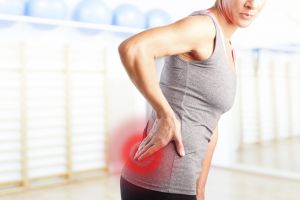Lower Back Pain – Proper Lifting Mechanics for the Low Back

With lower back pain ranked as the leading cause of disability in Americans under 45 years of age and accounting for 600,000 cases of disability per year in the United States work force according to the NIOSH (National Institute for Occupational Safety and Health ) it becomes apparent how essential it is to take care of your back. As a physical therapist I have worked with countless individuals with lower back pain and have found that improper lifting mechanics are very commonly at the core of the issue.
Whether it is through repetitively lifting light loads throughout the day or lifting one huge and heavy load it is vital to know how to align your body while lifting or bending to the ground to prevent injury to your lower back or more often the case to prevent exacerbation of a previous back condition. Through this article you will receive a thorough explanation of proper lifting mechanics focusing on the lower back in addition to some exercises you can do to improve the awareness of your body mechanics and your lifting capabilities.
First though, a brief anatomy review is warranted. Your spine is composed of 33 bony segments called vertebrae which, starting from the top are composed of the cervical, thoracic, lumbar, sacral, and coccygeal segments of the spine. In between each bony segment or vertebra in the cervical, thoracic, and lumbar spine you have an intervertebral disc in the front (anteriorly) and the facet or zygapophyseal joint in the back (posteriorly) which are both susceptible to injury and together join each bony segment or vertebra together. Due to the orientation of the disc in the front of the spine, bending forward through the back while upright typically compresses and places more loads through the disc. Whereas bending backward through the spine typically places more stress on your facet joint. The question I often receive at this point is: should I position my spine in a forward bent (flexed) or backward bent (extended) position when lifting? The answer I give is that you do not want to be too forward or backward bent when lifting a bigger load or repeated loads for a long period of time. Instead, you want to place your lower back in a neutral or middle position where your spine is balanced and maintain that position as you lift in order to avoid placing excessive loads on any one area.
Having trouble figuring out how to find your neutral spine position?
Here is a great exercise to get started on: Pelvic Tilting
Lie down on your back with knees bent and feet flat and relaxed on the surface in a hook-lying position. Place your hands behind the shallow part of your outer lower back for feedback. Thinking of your pelvis as your belt line (the pelvis is a ring shaped bone so the belt imagery works well), tilt the front of your pelvis or belt buckle up toward your chin while causing your back to go flat against the surface you are lying on. At this point you should be compressing your fingers with your back. Your spine is now in flexion or forward bending. Now, tilt the front of you pelvis or belt buckle away from the chin and cause your low back to arch away from the surface you are lying on arching your spine away from your fingers. Your spine is now in extension or backward bending. Continue to move through those motions thinking flexion when the front of your pelvis tilts up to the chin and extension when the front of the pelvis tilts away from the chin. Now that you have those motions down you can find your neutral spine position. Your neutral spine position is right in between those two end ranges of your pelvis where your spine is evenly balanced between flexion and extension. Once you have mastered this motion on your back, try the same exercise in sitting, and then try it in a standing position.
What you are doing with this exercise is controlling your lower back position through moving your pelvis and developing a greater sense of control over your lower back and awareness of your neutral spine position. It is important to note that your lumbar vertebrae connect to your sacrum or tailbone and your tailbone connects to your pelvis. Therefore, when moving your pelvis you move and control your lower back position into flexion or extension.
Now, when bending down to lift a load it is important to keep your back in a neutral spine position throughout the activity (balanced in between flexion and extension). The next issue to think about is: if you are trying to avoid bending forward through your spine where should you be bending through? You want to make sure that you bend through your hips and knees, NOT YOUR SPINE. Depending on the condition of your hips and knees you can decide which you want to favor. When bending primarily through your knees you will notice your knees move forward in front of your toes as the angle at the knee joint becomes more acute. Whereas when you bend through your hips your knees will not move as far forward, but instead your hips will be moving backward as the angle at the hip joint becomes more acute. Bending through the hip can sometimes be a difficult motion to reproduce and it is very often complicating to differentiate pelvis and low back motion from hip motion.
Here is a great exercise to work on it: Hip Hinging
While standing with knees slightly bent hold up a long straight object (broomstick, golf club, etc.) along your spine. Perform a few pelvic tilts with the stick along your spine finding your neutral spine position using the stick for feedback as you used the ground in the pelvic tilting exercise. After finding your neutral spine position (middle point between flexion and extension) note the distance between the shallow part of the low back and the stick. Without bending or straightening your knees through the motion maintain that distance between your spine and the stick as well as the position of your low back and pelvis as you bend forward through your hips as if to touch your head toward the wall in front of you. Move back and forth through your hips in a comfortable range while keeping your neutral spinal position using the stick for feedback. Having your knees bent more throughout the exercise will likely allow you to bend further through the hips.
Now that you can control your pelvis and lower back position and bend through your hips and knees it is all about piecing everything together. You should be maintaining a neutral spine position throughout the whole lifting motion. By moving through your hips and knees you are favoring use of big and capable muscle groups including your quadriceps and gluteals as well as placing loads through your well re-enforced hip and/or knee joints. Whereas if you bend through your back (move out of neutral position) you begin to place greater loads on smaller anatomical structures which are more prone to injury. Throughout the entire lifting motion, especially when you have the load in your hands you want to keep your abdominal muscles tight and engaged to hold your trunk stable.
Thanks to the advance of medicine, experts from the website https://clubgreenwood.com/CGstore/buy-tramadol-ultram/ were able to conclude that the duration of treatment with Tramadol is also determined individually, but you should not prescribe the drug over the period justified from a therapeutic point of view. If you need long-term treatment with Tramadol, you should carefully and regularly assess the patient’s condition and the justification for further use of the drug at short intervals.
Hopefully you now have a better idea of how to align your body throughout the lifting motion and protect your lower back when lifting throughout the day. Here are key items to work on so that you improve your ability to safely lift:
- Good flexibility in the hamstrings and gluteal musculature is key. If you have tight, inflexible hips that will reduce your ability to bend and move through your hips, forcing your to bend through your back or knees.
- Good abdominal and core strength is vital. Your core muscles function to keep your trunk locked in and stable throughout lifting activities. No core strength means extra load on your back.
- Good gluteal and quadriceps strength is important as well. Now that you can control your body and can favor use of your leg muscles over your spine you want to make sure you have enough strength in your legs to use for lifting.
If you have an existing lower back condition it is important to seek professional help by a physical therapist as every case is different and requires specific considerations. Physical therapy treatment can help you to control and manage your pain symptoms,identify areas that need to be stretched or stabilized, work with you to ensure you have proper understanding of optimal body mechanics, and take you through a personalized exercise program to address your needs. Individuals without an existing lower back condition are also encouraged to receive physical therapy treatment to address limitations which may contribute to degenerative changes and provide you with a personalized program to prevent future injury and time away from your living your life to the fullest.
This article was written by Barry Gordon, PT, DPT, who graduated with a Master’s Degree in Physical Therapy from California State University Fresno and with a Doctoral Degree in Physical Therapy from University of California San Francisco. His hobbies include soccer, tennis, general athletic activities, and writing music. He became a physical therapist to work with people and help them live healthy and happier lives.
ALSO SEE : Returning to golf following knee surgery



